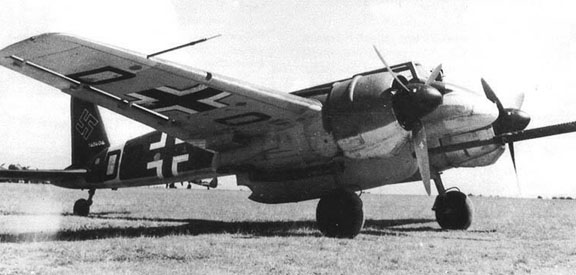The Hurricane Mk.II used the 1280 hp (take off) Rolls-Royce Merlin XX 12 cyl., supercharged engine, giving it a speed of 334-342 mph depending on the version (550km/h), a ceiling of 36,475 ft (11,125m), and a range of 480 mi (772 km). The Mk IIB packed a mighty punch with twelve 0.303 machine guns and could carry two 250 or 500 lb (227kg) bombs, or alternatively 45 or 90 gallon drop tanks. The Mk IIC carried four 20 mm British-made Hispano cannons, two in each wing. The real bruiser in this series was the Mk IID carrying two 40 mm Vickers cannons and two 0.303 in. machine guns and extra armour for low level attacks on armoured vehicles. All of the extra weight reduced the speed and range of the aircraft.
So,why don't the axsis have a genuine tank buster like the
ju-87g or the Hs-129?

The Ju 87G was the final version of the Stuka. It abandoned the dive attack in favour of an armament of two 37mm Rheinmetall-Borsig BK3,7 anti-tank cannon. These weapons fired special armour-piercing ammunition, with tungsten cores, at a muzzle velocity of 850m/sec. They were installed in gun pods fitted outboard of the landing gear legs. The ammunition was in six-round clips. The first operational trials were made in March 1943. The normal 7.9mm or 20mm wing guns were deleted. Dive bombing was not possible with the additional weight of the guns, so the dive brakes were also deleted -- the Ju 87G could still drop bombs, but not in a dive.
Initially, the Ju 87G was seen as quite dangerous to its crews. The additional weight and drag of the wing guns adversely affected performance and handling, and low-level attacks in the face of the Russian AAA and fighters seemed suicidal. But true as that was, it remained that the Ju 87G was extremely effective. The 37mm gun was in 1943 considered obsolete as an anti-tank gun on the ground, but from the air it was still effective, because the Ju 87G could attack tanks from the rear or from above, were their armour was much thinner. Not that the Germans refrained from trying out bigger cannon on anti-tank aircraft, but the Ju 87 could not possibly carry these, and larger aircraft such as the Ju 88 were not agile enough to operate successfully against tanks.
There were two versions, the G-1 and the G-2, with short and long wing spans, respectively -- the G-2 was based on the long-wing D-5 model. Production of the Ju 87 was halted definitively in October 1944.

Hs 129B-1/R1: No fuselage hardpoint.
Hs 129B-1/R2: Added a 30mm Mk 101 cannon with 30 rounds in a tray under the fuselage. No fuselage hardpoint.
Hs 129B-1/R3: Added four MG 17's with 250 rounds per gun in a tray under the fuselage. No fuselage hardpoint.
Hs 129B-1/R5: Added a Rb 50/30 camera for reconnaissence duties. No fuselage hardpoint.
Hs 129B-2/R1: Replaced the two nose MG 17's with two 13mm MG 131's. The first B-2's saw action in early 1943 against the Soviets.
Hs 129B-2/R2: As B-2/R1, but added 30mm Mk 103 cannon with 30 rounds in a tray under the fuselage.
Hs 129B-2/R3: As B-2/R2, but use a 37mm BK 3.7 gun instead.
Hs 129B-2/R4: As B-2/R2, but mounted a 75mm Pak 40L in an underfuselage pod with 12 rounds. Weight and stall speed increased to 6.9 tons and 91 mph, respectvely, and aMR dropped to 3.
Hs 129B-3/Wa: As B-2/R4, but with the 75mm BK 7.5 cannon and 26 rounds instead. The pod could be jettisoned in an emergency. Only 25 were made, due to the gun being too much for the airframe and disruption from Allied bombing.
Hs 129C: This planned upgrade would have used two 627-kW Italian engines and had a limited traverse ventral turret with two 30mm Mk 103 cannons. The design was dropped after Italy surrendered and the engines became unavailable.
http://www.warbirdsresourcegroup.org/LRG/hs129.html